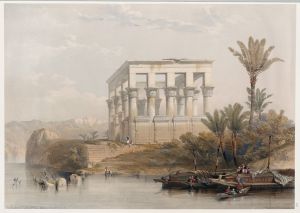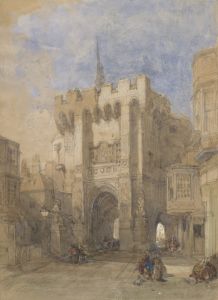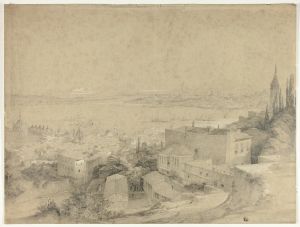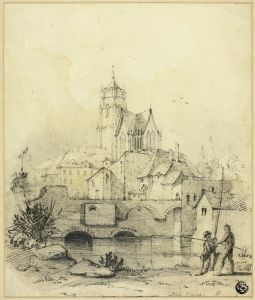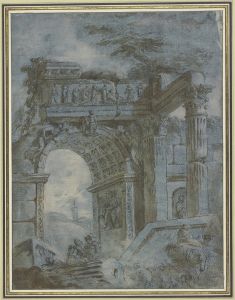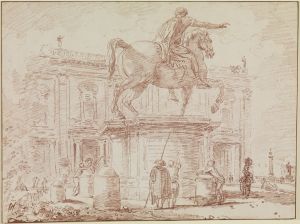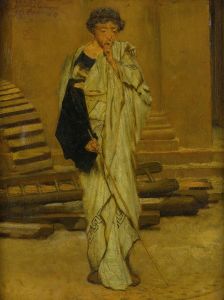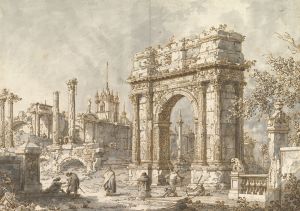
Baalbec,Ruins of the Temple of Bacchus
A hand-painted replica of David Roberts’s masterpiece Baalbec,Ruins of the Temple of Bacchus, meticulously crafted by professional artists to capture the true essence of the original. Each piece is created with museum-quality canvas and rare mineral pigments, carefully painted by experienced artists with delicate brushstrokes and rich, layered colors to perfectly recreate the texture of the original artwork. Unlike machine-printed reproductions, this hand-painted version brings the painting to life, infused with the artist’s emotions and skill in every stroke. Whether for personal collection or home decoration, it instantly elevates the artistic atmosphere of any space.
"Baalbec, Ruins of the Temple of Bacchus" is a painting by the renowned Scottish artist David Roberts, known for his detailed and romanticized depictions of architectural and historical sites. Roberts was a prominent figure in the 19th-century Orientalist movement, which focused on the portrayal of the Middle East and North Africa through European artistic perspectives. His works are celebrated for their accuracy, attention to detail, and the ability to capture the grandeur of ancient structures.
David Roberts was born in 1796 in Stockbridge, Edinburgh, and began his career as a scenic painter for theaters in Scotland and London. His passion for travel and architecture led him to embark on a grand tour of the Middle East in 1838-1839. During this journey, Roberts visited Egypt, the Holy Land, and Lebanon, where he sketched numerous ancient sites, including the ruins of Baalbek.
Baalbek, located in modern-day Lebanon, is one of the most significant archaeological sites in the Middle East. It was known as Heliopolis during the Roman Empire and is famous for its well-preserved Roman temples. The Temple of Bacchus, one of the best-preserved Roman temple ruins, is dedicated to Bacchus, the Roman god of wine, fertility, and revelry. This temple is renowned for its grand scale and intricate architectural details, including its Corinthian columns and richly decorated stone carvings.
Roberts' painting captures the majestic ruins of the Temple of Bacchus with remarkable precision. His work is characterized by a meticulous attention to architectural detail, which he achieved through on-site sketches and studies. The painting reflects the romantic allure of ancient ruins, a common theme in 19th-century art, which often emphasized the sublime and the picturesque.
The painting is part of a larger collection of works that Roberts produced based on his travels in the Middle East. These works were later published as lithographs in a series titled "The Holy Land, Syria, Idumea, Arabia, Egypt, and Nubia," which gained widespread acclaim and contributed significantly to Roberts' reputation as a leading Orientalist artist. The lithographs were produced by Louis Haghe, a skilled lithographer, and were noted for their high quality and fidelity to Roberts' original sketches.
Roberts' depictions of the Middle East were influential in shaping Western perceptions of the region during the 19th century. His works provided a visual record of sites that were, at the time, largely inaccessible to the general public. The romantic and exotic portrayal of these ancient ruins appealed to the Victorian fascination with the Orient and contributed to the broader Orientalist movement in art and literature.
"Baalbec, Ruins of the Temple of Bacchus" remains an important work in the study of Orientalist art and 19th-century travel painting. It exemplifies Roberts' skill in capturing the essence of ancient architecture and his ability to convey the historical and cultural significance of the sites he visited. Today, Roberts' works are housed in various museums and collections, where they continue to be appreciated for their artistic and historical value.







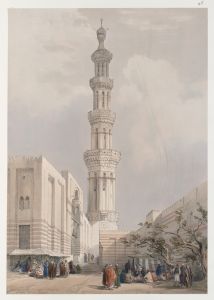
![Temple at Esneh [Isnâ]. Nov. 25th, 1838.](/imgs/217542/s/david-roberts-temple-at-esneh-isna-nov-25th-1838-c31fdf34.jpg)
